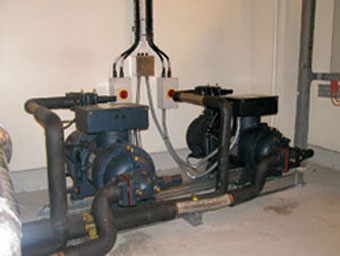Trevor Dann, operations director of Thermacom, discusses how to extend the life of water chillers and looks at solutions for energy reduction and compliance with Montreal Protocol
GUIDELINES for energy reduction in existing buildings are encouraging efforts to reduce power consumption by around 10% to 15%. However, during the recent hot spell the National Grid was hard pressed to manage demand and some areas of central London did experience power outages because of excessive grid load.
This was blamed on the increased demand from air-conditioning equipment.
The biggest single component on large air conditioning systems is the chiller. It is the compressor which uses a major part of the power, and as the ambient temperature rises, so does the condensing temperature and consequent condensing or head pressure. It is this direct loading upon the compressor, together with high loadings up on the chilled system (air or water) which pushes the compressor towards its upper operational limit and power (current) draw.
A typical chiller installation of four 500kW chillers may require an input energy in hot weather of 650kW (assuming a typical COP of around 3:1), and whereas most of the time actual power draw will be less, it must be considered whether plant of this nature is offering optimum energy usage throughout the year, not just in peak conditions.
So what can be done?
Most new chillers are supplied either with scroll or screw compressors, and these are very efficient because they use the continuous compression cycle. However, many older chillers, mostly R22 units, continue to operate with piston compressors.
Whereas piston compressors are arguably more efficient at lower loadings than screw machines, it is in higher load conditions that consideration of the maximum loading and power draw becomes crucial.
Another significant factor to consider with any R22 machinery is the phase out of HCFCs, due from 2009 under the Montreal Protocol timetable.
A major input energy saving can be demonstrated upon many chillers by effecting a conversion from reciprocating to screw or scroll compression. Such projects are not to be undertaken lightly, and certainly a pioneering attitude is needed for each and every project considered. However, it is this pioneering approach which has enabled a very successful project in London’s Docklands which has placed
Thermacom as a finalist in the 2006 Cooling Industry Awards.
On this project there were several significant problems:
• The equipment was about 15 years old;
• It was built-in;
• DX with variable air volume;
• Poor level of control with stage controlled compressors;
• Piston compression;
• Refrigerant was R22
New equipment was initially considered but this was not a favoured option. New equipment would have meant a major refurbishment affecting all areas of the building at once. The type of unit, a mammoth chiller/ahu which, although common in the US where it was made, is almost unheard of in Docklands.
However, installation of an entire chilled water system, plus associated fan coil units/ahus would not have suited the modular style of the building. Further, conversion would have been very expensive even if the building had not been occupied.
However, the units were in internal plantroom areas and, because of the obviously good routine of planned preventative maintenance, the units were structurally sound. The mechanical parts were tired but also highly serviceable.

The rebuilt compressors
The solution was a radical and pioneering conversion of the chillers:
• Mechanical parts – renewed (fan bearings, modulating valves, etc);
• Installation of highly efficient screw compressors with variable loading capability;
• Control of VAV air supply improved in conjunction with the variable load feature;
• Replacement of R22 with R417a (Isceon 59) which is Montreal Protocol compliance and also reduces energy consumption;
• Dramatically reduced power draw.
The effect of the upgrade was felt immediately by the building users:
• Consistent energy savings of 35% have been reported. Further, the increased efficiency of each chiller/ahu has allowed up to one-third of the total chiller units to be shut down in anything other than high ambient conditions, and this has meant overall power consumption has been reduced by more than 50%.
• Improved air supply temperature control plus some increase in cooling capacity achieved by the new gas and better effect across the evaporator coils has allowed the building to hold a higher working population.
• The equipment should provide another 15 years of life – if PPM continues – when it is probable the whole exercise could be repeated, at which time technology not yet available could then be considered.
• Minimal building disruption. Most projects were completed using only weekend working and interruption was no more than experienced on a typical unscheduled breakdown.
Thermacom T: 0118 950 0606